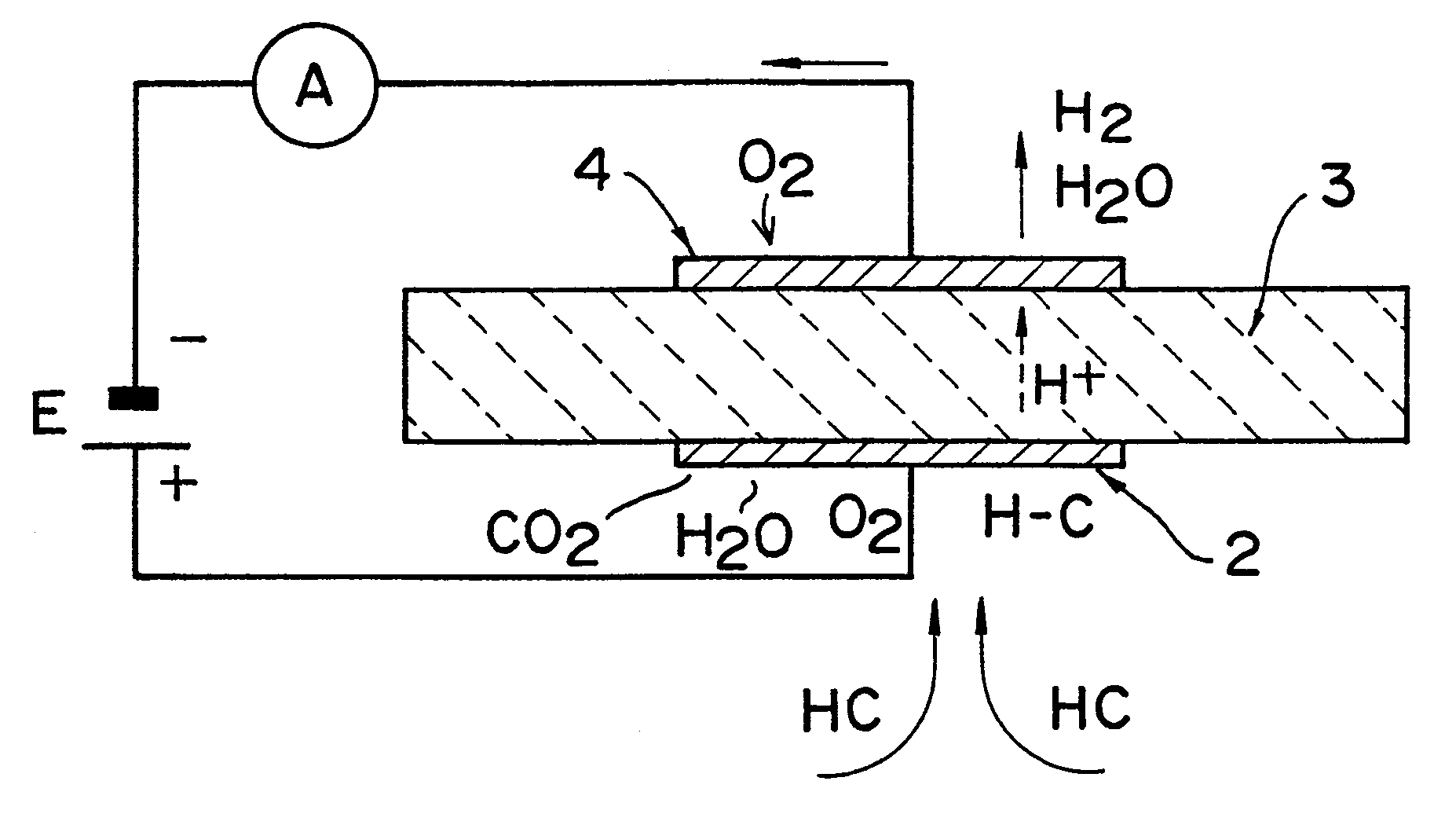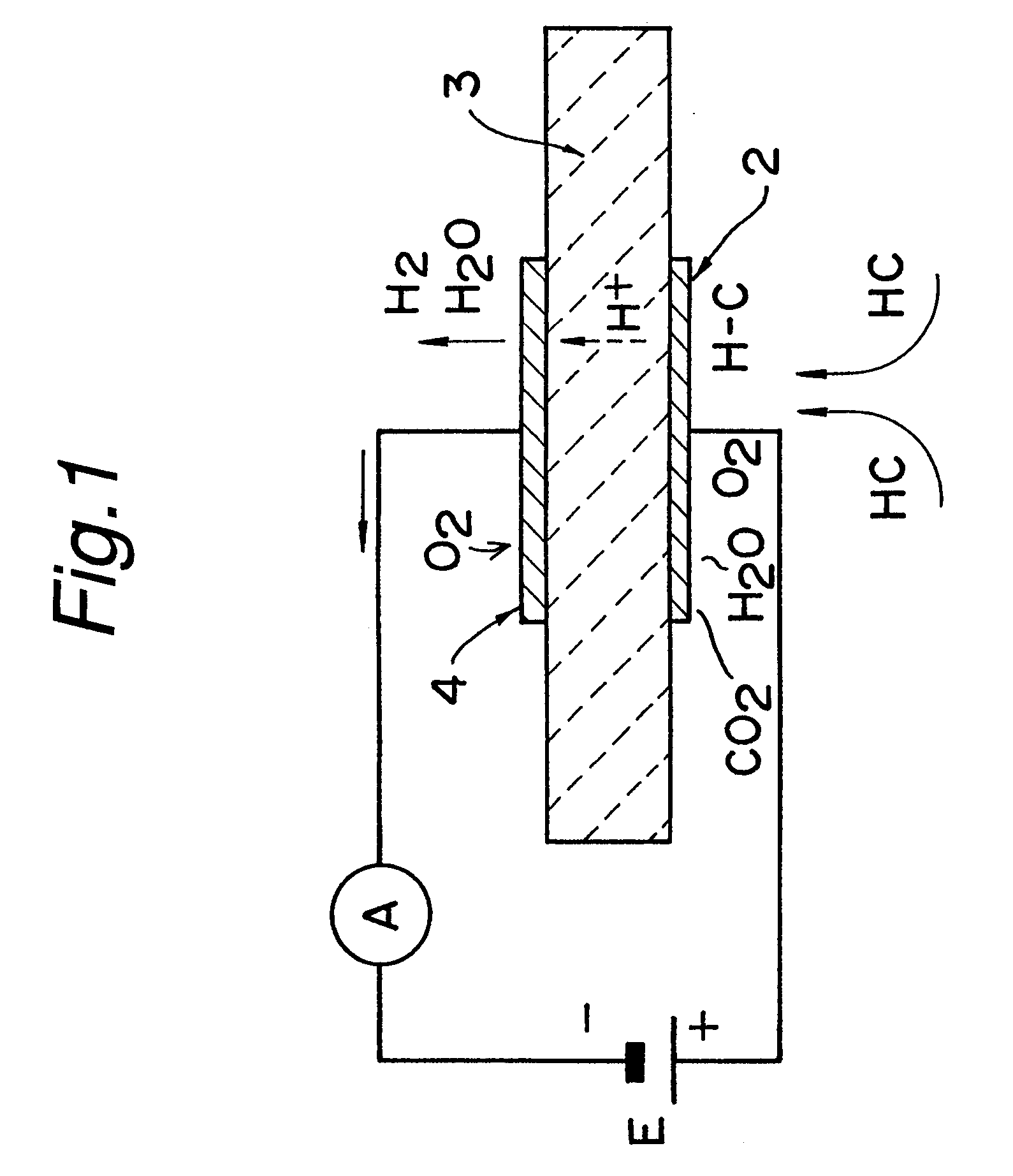Hydrocarbon sensor
- Summary
- Abstract
- Description
- Claims
- Application Information
AI Technical Summary
Problems solved by technology
Method used
Image
Examples
example 2
The present example is a hydrocarbon sensor comprising a pair of electrodes and a solid electrolyte 3 made of a Ba--Ce-based oxide and having a hydrocarbon diffusion rate determining layer, wherein the cathode thereof is made of a material mainly containing Al. In this example, an aluminum oxide layer is formed on the surface of the cathode made of Al.
FIG. 6 shows the structure of the limiting-current type hydrocarbon sensor of the present invention. The solid electrolyte 3 of the sensor was formed of a sintered body of BaCe.sub.0.8 Y.sub.0.2 O.sub.3-.alpha. having a size of 10 mm.times.10 mm and a thickness of 0.45 mm. An anode 2 was made of platinum, and a cathode 4 was formed of an Al-containing metal layer. In this example, to obtain a material mainly containing Al for the Al-containing metal layer, Al powder, 0.1% of Cu powder, 2% of Si powder and 2% of SiO.sub.2 powder were mixed, and paste was thus prepared. This paste was applied on the solid electrolyte 3 by screen printing...
example 3
The present example is a hydrocarbon sensor comprising a pair of electrodes and a solid electrolyte 3 made of a Ba--Ce-based oxide and having a hydrocarbon diffusion rate determining layer, wherein its anode is made of a material mainly containing Ag.
The solid electrolytic layer 3 of the sensor was formed of a sintered body of BaCe.sub.0.8 Gd.sub.0.2 O.sub.3-.alpha. having an external size of 10 mm.times.10 mm and a thickness of 0.45 mm. On the surfaces of a solid electrolytic layer 3, an anode 2 made of Ag was formed, and a cathode 4 made of an Al-containing material mainly containing Al was also formed as shown in FIG. 6. Each electrode material was formed into paste, and applied onto the solid electrolyte 3 by screen printing to form a film. After drying, the film was baked at 850.degree. C. to obtain a sintered electrode.
Furthermore, the solid electrolytic layer 3 on the side of the anode 2 was covered with a ceramic substrate 1 via an inorganic adhesive 8 to form a hydrocarbon ...
first embodiment
A hydrocarbon sensor in accordance with the present invention is a sensor for transferring an approximately constant amount of oxygen in an atmosphere under measurement to its cathode chamber by using a solid ion pump formed of an oxide ion conductor.
In the oxygen pump of this sensor of this first embodiment, as shown in FIG. 9A, the inner electrode 51 on the cathode chamber side is used as a positive electrode, and the outer electrode 52 is used as a negative electrode. A constant voltage or constant current is applied across the inner and outer electrodes to flow current through the pump-use solid-electrolytic layer 50, thereby to pass external oxygen through the solid-electrolytic layer and to move a constant amount of oxygen into the cathode chamber. The movement amount of the oxygen is controlled depending on current. In this process, a constant amount of oxygen in the cathode chamber decomposes at the cathode regardless of the concentration of the oxygen in an external atmosph...
PUM
 Login to View More
Login to View More Abstract
Description
Claims
Application Information
 Login to View More
Login to View More - R&D
- Intellectual Property
- Life Sciences
- Materials
- Tech Scout
- Unparalleled Data Quality
- Higher Quality Content
- 60% Fewer Hallucinations
Browse by: Latest US Patents, China's latest patents, Technical Efficacy Thesaurus, Application Domain, Technology Topic, Popular Technical Reports.
© 2025 PatSnap. All rights reserved.Legal|Privacy policy|Modern Slavery Act Transparency Statement|Sitemap|About US| Contact US: help@patsnap.com



